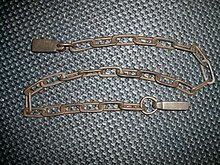Manriki Gusari
Manriki Gusari ( Japanese 万 力 鎖 ), also Kusarifundō , ( 鎖 分 銅 ) is a Japanese weapon. The name means something like "chain of 10,000 possibilities".
The Manriki Gusari belongs to the group of Kobudō weapons. These are unconventional weapons that the samurai often felt to be unworthy and therefore not recognized. Fighting with this weapon is taught in the Japanese or Okinawan Suruchin system.
Appearance and handling
The weapon consists of a chain and an iron weight at each end, which can have various shapes from cylindrical to round. The chain is mostly adapted to the body size and therefore exists in different lengths, mostly it is between 60 centimeters and 4 meters long.
The advantages of the weapon are, on the one hand, that you can hide it well and use it for a surprise attack, and on the other hand, the high flexibility, which makes it very difficult for the opponent to block the weapon.
However, the weapon requires a high level of training and body control. Without appropriate training, the weapon quickly becomes a disadvantage for the user and an advantage for the opponent in combat, since the risk of self-harm is very high. In addition, the weapon is very difficult to use effectively in confined spaces.
history
The Manriki Gusari probably developed from the Chinese section whip . It is said to have originally come from Edo (today's Tokyo ) and developed by the gatekeeper of the castle in Edo, Masaki Toshimitsu, about 300 years ago. It was used as a defensive weapon against the sword and should be used to defeat swordsmen in a bloodless manner, since the gate of the castle should not be stained with blood.
Due to the compactness and easy handling of the weapon, it soon became a popular secondary weapon for samurai, which was carried in a leather pouch on the side and, like the wakizashi, was only put down to sleep. Later it was mainly used by the ninja . In the course of time a large number of schools ( ryuha ) were formed, of which only a few have survived . Today it is mostly only used in ninjutsu . Fighting with this weapon is now only taught in traditional schools.
